#cognitive-science
Explore tagged Tumblr posts
Text
Science side of Tumblr PLEASE share your tips/advice/hacks for academic conferences!
Im attending my first academic conference in a couple weeks and I’d appreciate anything you’d like to share with a lil baby bio undergrad like me
#science side of tumblr#science student#science stuff#science#research scientist#biology#research#conference#psychology#cognition#cognitive science#wildlife biology#zoology#ethology#ecology#evolution#medicine#med school
2K notes
·
View notes
Text
Cognitive Techniques To Change Your Thoughts ✨✨
Cognitive techniques are strategies used in cognitive therapy to help you identify and change negative thoughts and beliefs. These techniques should be practiced regularly so that they become habits.
Cognitive Restructuring: This involves identifying and challenging negative or irrational thoughts and replacing them with more positive or rational beliefs.
Thought Stopping: When you notice a negative thought entering your mind, you can mentally shout "Stop!" This interrupts the thought process and gives you a chance to replace the negative thought with a positive one.
Mindfulness and Meditation: These practices help you become more aware of your thoughts and feelings in the present moment. When you observe your thoughts without judgment, you gain insight into negative patterns and choose to let them go.
Journaling: Writing down your thoughts can help you process and analyze them. With time you can identify patterns and work on changing negative thought cycles.
Positive Affirmations: Repeating positive statements can help counteract negative self talk and reinforce positive beliefs about yourself.
Evidence Collection: When faced with a negative belief, ask yourself, "What evidence do I have that supports or refutes this thought?" This can help you see things in a more balanced way.
Decatastrophizing: If you tend to imagine the worst scenario, ask yourself how likely it is to happen and what other possible outcomes there might be. This can help you view situations more realistically.
Labeling: Instead of saying "I am a failure," label the thought as "a negative thought about my abilities."
Distraction: Engaging in an activity or hobby can divert your attention from negative thoughts and give your mind a break.
Scheduling Worry Time: Instead of ruminating on worries throughout the day, set aside a specific time to process them. This can prevent constant worry and allow you to focus on other tasks.
Challenging Cognitive Distortions: Recognize and challenge cognitive distortions like black-and-white thinking, overgeneralization, and personalization.
Visual Imagery: Visualize a place or situation where you feel calm and happy. This can help shift your focus from negative thoughts.
These are very simple descriptions and examples of cognitive techniques. I listed the ones we can put into practice on our own. There are more in depth methods and practices used by doctors on different fields of study and practice. I can list, as well as add upon the information listed here.
#cognitive science#cognitive behavioral therapy#psychology#personal improvement#personal development#personal growth#self help#self improvement#self care#limiting beliefs#positive mindset#affirmations
5K notes
·
View notes
Text
why neuroscience is cool
space & the brain are like the two final frontiers
we know just enough to know we know nothing
there are radically new theories all. the. time. and even just in my research assistant work i've been able to meet with, talk to, and work with the people making them
it's such a philosophical science
potential to do a lot of good in fighting neurological diseases
things like BCI (brain computer interface) and OI (organoid intelligence) are soooooo new and anyone's game - motivation to study hard and be successful so i can take back my field from elon musk
machine learning is going to rapidly increase neuroscience progress i promise you. we get so caught up in AI stealing jobs but yes please steal my job of manually analyzing fMRI scans please i would much prefer to work on the science PLUS computational simulations will soon >>> animal testing to make all drug testing safer and more ethical !! we love ethical AI <3
collab with...everyone under the sun - psychologists, philosophers, ethicists, physicists, molecular biologists, chemists, drug development, machine learning, traditional computing, business, history, education, literally try to name a field we don't work with
it's the brain eeeeee
#my motivation to study so i can be a cool neuroscientist#science#women in stem#academia#stem#stemblr#studyblr#neuroscience#stem romanticism#brain#psychology#machine learning#AI#brain computer interface#organoid intelligence#motivation#positivity#science positivity#cogsci#cognitive science
2K notes
·
View notes
Text
I just had a talk with my thesis supervisor and I want to check something real quick.
I want to write my bachelor's thesis about fanficion and AI - specifically about fanfiction writers' attitude towards the use of generative AI in fandom spaces
The survey (and the rest of the thesis) is still v much in the making, I just want to check how many potential responders I could reach from this account
Pls reblog after voting
What I can say about the survey for now:
1. The survey will be anonymous!
2. The survey will be in English (but the rest of my thesis will not. I am however required to write an abstract in English)
3. My supervisor said it's fine if I want to focus on one fandom - In this case it will be the HP fandom. However I would like to include as many reposnes as I can, so it will probably not be a requirement to be in the HP fandom.
4. You don't need to write fanfiction to take part in the survey (but there will be a question if you read and/or write fanfics). You need to be in the fandom though
5. You need to be over 18 (most likely)
I want to keep myself anonymous as well so there is a possibility I will have to make a separate sideblog/account for it.
If anyone will be interested in the results, for some reason - I am required to write the abstract in English, so I might share the abstract. Maybe. More info after I write anything for my thesis.
#fandom#hp fandom#fanfiction#fanfic writers#cognitive science#generative AI#AI#survey#thesis#ao3#archive of our own#nyx writes her bachelor's
382 notes
·
View notes
Text

On today's todo list:
Draft and schedule emails
Review existing literature on my PI's current research direction
Review previous NSF GRFP applications
Look into other national fellowships (listed)
Brainstorm about personal statements + project proposals
I've unfortunately fallen off my daily journaling/work routines the last few months, and I'm working on getting myself back into good habits. Today, my main goal is to schedule all my emails to other PhD programs their declining offers of admission. I just finalized everything with my chosen program this week, and the April 15th decision deadline is looming. I feel terrible for dragging my feet on communications, but I want to make sure I send personalized emails to each professor I interviewed with. I know this is part of the process, but I still hate disappointing people.
On the upside, I've already set up my graduate school accounts, put together a preliminary schedule of my classes in the fall, and set up my new email. I'm eager to get back to work
151 notes
·
View notes
Note
okay so uploading ur consciousness is a bad idea obviously BUT what if you ship of theseus'd the brain itself
like one neuron at a time


as much as i disagree with John Searle about pretty much everything (including his second scenario here, which i personally find a bit dramatic), i do have to give him credit for foreseeing basically every single relevant cognitive science question of the next half-century and showing his work for how he arrives at his conclusions. he wrote this in 1992
#there's an old joke saying that the entire field of cognitive science is just trying to prove Searle wrong and it's barely a joke#as much as i disagree with him he is one of the most internally consistent thinkers in any field
151 notes
·
View notes
Text
I have a certain amount of admiration for cognitive scientists who are prepared to cut the Gordian knot of defining what a mind is and simply deny the validity of their own subjective experience. I mean, obviously someone who looks you in the eye and says "I'm not actually conscious, I just behave as though I am" is full of shit, but you've gotta respect the audacity.
3K notes
·
View notes
Text
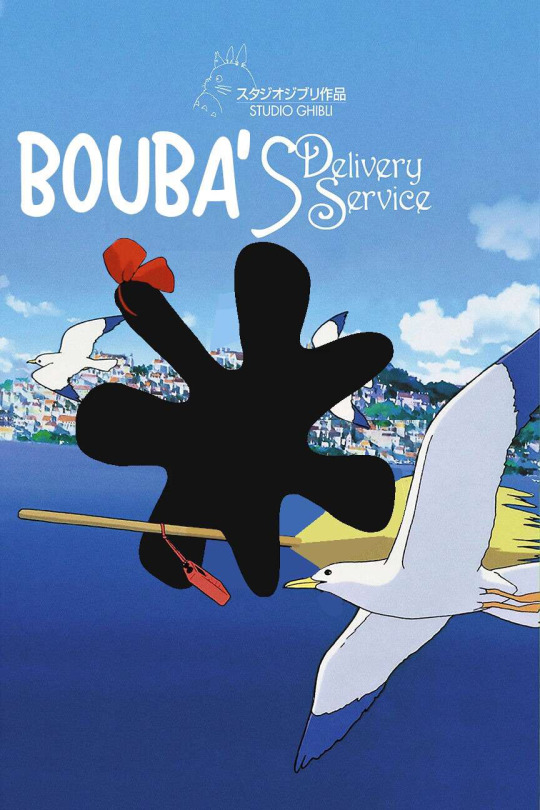
99 notes
·
View notes
Text

140 notes
·
View notes
Text
What Pride Flags Mean, Part 1: Gender and Attraction
Welcome to the latest installment of my autistic hyperfixation on flags! I wanted to figure out a common language of Colour X means Thing Y. Like how pink is consistently used for feminine.
Having a common language for flag meanings matters because it improves cognitive accessibility of flags. ♿️💙
But I didn't want to be prescriptive about what colours should mean what. Just because I think Thing X should go with Colour Y doesn't mean everybody else would.
So this turned into a descriptive, empirical project. I gathered a data set of 2060 pride flag colour choices to figure out what are the most common colour-meaning combinations. Some of the results:
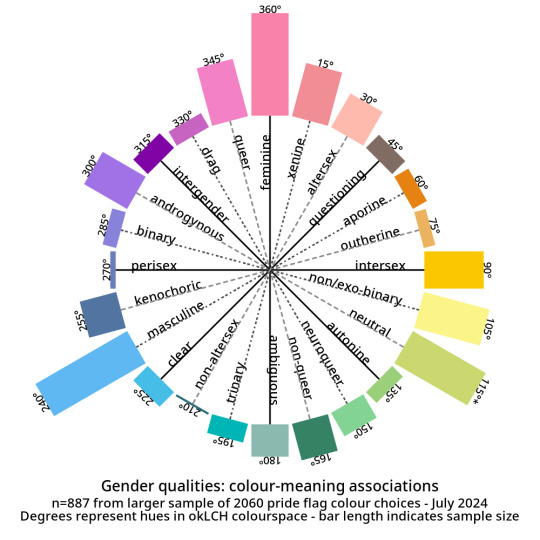
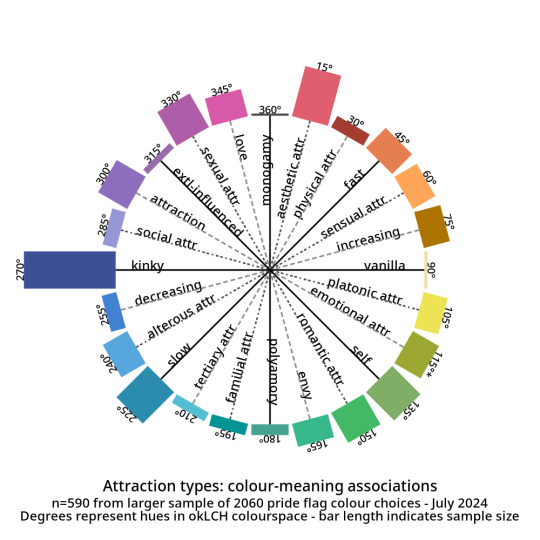
And here are the abstract modifiers: these are modifiers that were generally shared between the genders and the attractions. For example, black is used to indicate having no gender as well as having no attraction.
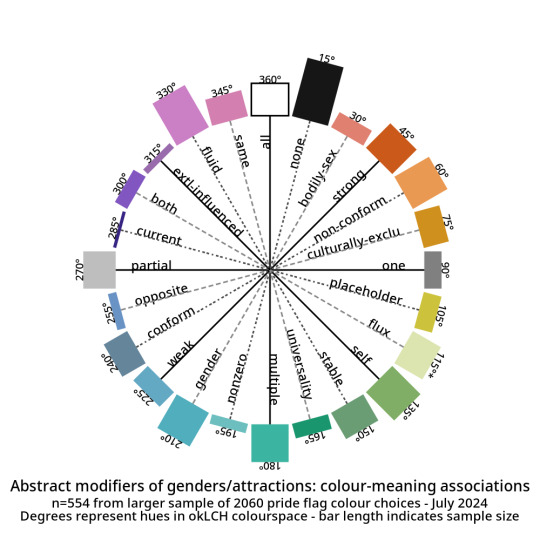
Click here for tables with okLCH values, hex values, definitions, and notes - I've put a more detailed write-up on my Wikimedia Commons userpage. (Mediawiki supports sortable tables and Tumblr does not.)
METHODS-AT-A-GLANCE
To make the figures above, I assembled a data set of pride flag colours. It contains 2060 colour choices from 624 pride flags, representing 1587 unique colours. Click here for a detailed description of how I gathered and tagged the pride flag colours and tagged them.
For each tag, I converted every colour to okLCH colour space and computed a median colour. OkLCH colour space is an alternative to RGB/hex and HSL/HSV. Unlike RGB/hex and HSL/HSV, okLCH is a perceptual colour space, meaning that it is actually based on human colour perception. 🌈
In okLCH space, a colour has three values:
- Lightness (0-100%): how light the colour is. 100% is pure white.
- Chroma (0-0.37+): how vibrant the colour is. 0 is monochromatic. 0.37 is currently the most vibrant things can get with current computer monitor technologies. But as computer monitor technologies improve to allow for even more vibrant colours, higher chroma values will be unlocked.
- Hue (0-360°): where on the colour wheel the colour goes - 0° is pink and 180° is teal, and colours are actually 180° opposite from their perceptual complements.
The important thing to know is that okLCH Hue is not the same Hue from HSV/HSL - the values are different! (HSL and HSV are a hot mess and do not align with human colour perception!)
You can learn more about okLCH through my little write up, which was heavily influenced by these helpful articles by Geoff Graham, Lea Verou, and Keith J Grant.
You can play with an okLCH colour picker and converter at oklch.com
🌈
MORE RESULTS: COLOUR DISTRIBUTIONS
Back when I started tagging my data, I divided my data into five main chunks: Gender qualities (e.g. masculine, androgynous), Attraction (e.g. platonic, sexual), Values (e.g. community, joy), Disability (e.g. Deaf, blind), and Other.
I'll talk about Disability and Values in future posts! But for an alternate view of the data, here are the full distributions of the colours that were placed in each tag.
They come in three parts: tags I created for Gender, tags for Attraction, and tags from Other. The abstract modifiers are spread between the first two, though their contents transcend Gender and Attraction.
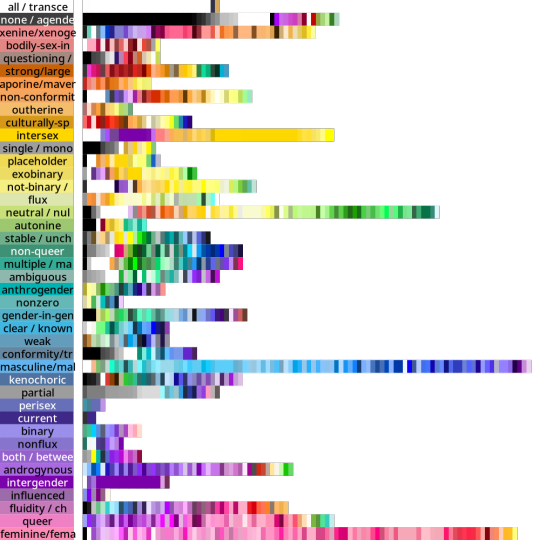
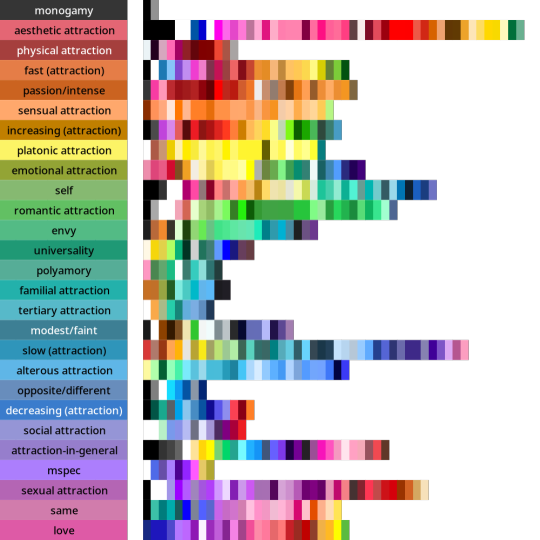
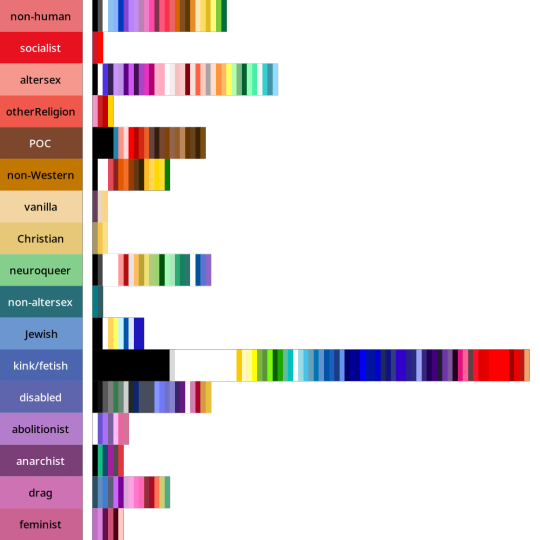
Some distributions have a lot more variance within them than others. Generally speaking, major attraction types tended to have the least variance: sensual attraction is really consistently orange, platonic is really consistently yellow, etc.
Variance and size do not correlate. Many of the smaller tags are quite internally consistent. I don't have a ton of tags in "current gender" but they're all the same dark purple. Xenine/xenogender has a whole bunch of entries, and there's a really big spread from blue to yellow.
Some tags, like intersex as well as kink/fetish show there are a small number of different colours that are very consistently used. Whereas other tags like masculine show a very smooth range - in this case from cyan to purple.
Overall I'm pretty satisfied with how things wound up! 🥳 It makes sense to me that an umbrella term like xenogender would have a lot of variance. What honestly makes me happiest is just how many tags wound up 180 or 90 degrees from their opposites/complements. 🤩
Not everything lined up nicely (the opposite of drag is .... neuroqueer? awkward.) 🤨 Some things lined up in hilarious ways, like how initially I had the opposite of kink/fetish being Christian (amazing.)
But as a whole, there's a lot of structure and logic to where things landed! I hope this makes sense for other people and can help inform both flag making as well as flag interpreting (e.g. writing alt-text for existing flags). 🌈
I'm hoping to post the Disability and Values analyses in the coming days! If you want to learn more, my detailed notes along with tables etc are over on my Wikimedia Commons userspace. 💜
Everything here is Creative Commons Sharealike 4.0, which means you're free to reuse and build on my visualizations, tables, etc. Enjoy!
#lgbt#lgbtqia#mogai#mogai flag#mogai flags#lgbtq flags#lgbt flags#lgbtqia+#vexillology#flags#colours#oklch#colour nerdery#colour theory#colour science#cognitive accessibility#design
200 notes
·
View notes
Text
The Institute for Psychogametous Life: A Novel Approach to Investigating Symbolic Alien Replication and Human Cognitive Response
Just published: The Institute for Psychogametous Life: A Novel Approach to Investigating Symbolic Alien Replication and Human Cognitive Response. Read the paper. Abstract
The discovery of the "Alien Botany" archive from the ill-fated Novy Mir mission has unveiled a unique and perplexing phenomenon: the apparent replication of alien botanical imagery within the human mind, manifesting as vivid palinopsia and an ideomotor compulsion to recreate these forms. This paper describes the establishment of the "Institute for Psychogametous Life (IPGL)," a novel research and public engagement facility designed to investigate this phenomenon. The IPGL employs a multi-faceted approach, combining controlled sensory environments, physiological and psychological monitoring, and public interaction to elucidate the mechanisms underlying image germination and its potential implications for understanding symbolic alien life and human cognitive susceptibility. We argue that treating the human public as active participants in this process is crucial for advancing our knowledge of this extraordinary phenomenon.

#Semiotics#Posthumanism#Visual Semiotics#Symbolic Anthropology#Avant-Garde#Alien Botany#Symbolic Replication#Palinopsia#Ideomotor Reflex#Science#Public Engagement#Exobiology#Institute for Psychogametous Life#zoetica ebb#my work#artists on tumblr#xenopoem#cognitive science
50 notes
·
View notes
Text
we have a cognitive science reading group btw which is awesome and open to everyone. if you're interested in finding out more and joining the group, check out this short survey! looking forward to reading with you <3
#PLEASE BOOST! THANK YOU! WAHHHHHHHHHH#do I dare.#cognitive science#HERE WE GO.#so THIS happened type post. before the boost there's the flop.
28 notes
·
View notes
Text


A polynon is a conceptual geometric entity of which vertices are non-events and its edges holograms.
A polynon contains all the holograms of that which can be projected as a polytope, showing how consciousness can be fundamental.
In the Hexanon, shown above, the Observer O(n) is in superposition with the phenomenal p+, epiphenomenal p-, negative noumena n- and noumenal vertices n+ of the hexanon as a function for self-reflection of consciousness C.
The polynon is built on the lens mechanism of the wavefunction: each layer of the noumenal lens is a wavefunction in itself, providing mechanism for the observer as function of noumenal reflection.
The paper is now available on philpapers, as well: https://philarchive.org/rec/ROITPA
57 notes
·
View notes
Text
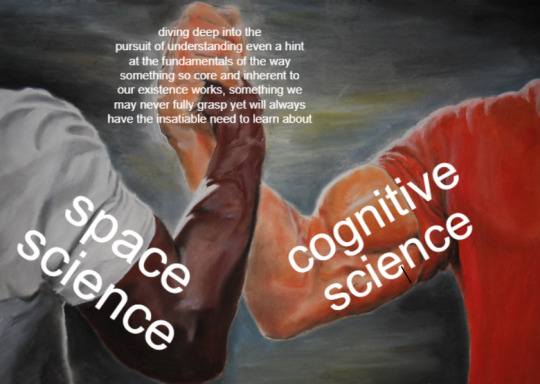
#science#women in stem#academia#stem#stemblr#space science#physics#astrophysics#astronomy#quantum mechanics#general relativity#cognitive science#psychology#neuroscience#cognitive neuroscience#philosophy of science#stem romanticism#stem memes#physics memes#science memes#neuroscience memes
396 notes
·
View notes
Text
Interesting Reviews for Week 13, 2025
Neural circuits for goal-directed navigation across species. Basu, J., & Nagel, K. (2024). Trends in Neurosciences, 47(11), 904–917.
Neural Network Excitation/Inhibition: A Key to Empathy and Empathy Impairment. Tang, Y., Wang, C., Li, Q., Liu, G., Song, D., Quan, Z., Yan, Y., & Qing, H. (2024). The Neuroscientist, 30(6), 644–665.
Event perception and event memory in real-world experience. Bailey, H., & Smith, M. E. (2024). Nature Reviews Psychology, 3(11), 754–766.
Plasticity of Dendritic Spines Underlies Fear Memory. Choi, J. E., & Kaang, B.-K. (2024). The Neuroscientist, 30(6), 690–703.
#neuroscience#science#research#brain science#scientific publications#cognitive science#reviews#neurobiology#cognition#psychophysics#computational neuroscience
28 notes
·
View notes
Text



05.05.2025
Had an unexpected day off to enjoy the nice weather, and took advantage of it! I think I have a solid idea for a first year project that builds off of the preexisting literature well. I hope my PI agrees! I have to shoot her an email, but I'm concerned about coming off as high maintenance before the semester starts...
I also reread a couple of my favorite chapters in The King in Yellow; the stories about the art students fill me with a soft sense of longing I quite like. Turns out Chambers' other novel In the Quarter is available online, so I read that in its entirety yesterday as well because I have no self-control.
#mine#personal#language#study#studyblr#academia#dark academia#light academia#phdblr#psychology#cognitive science#psych#cogsci
23 notes
·
View notes